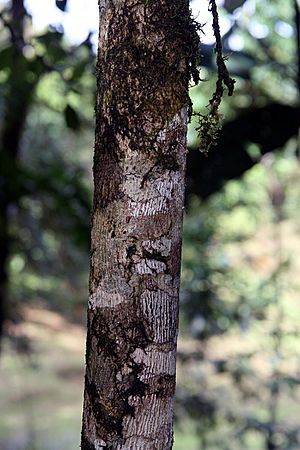Terminalia amazonia facts for kids
Quick facts for kids Terminalia amazonia |
|
|---|---|
 |
|
| Leaves of Terminalia amazonia | |
| Conservation status | |
| Scientific classification | |
| Genus: |
Terminalia
|
| Species: |
amazonia
|
| Synonyms | |
|
|
Terminalia amazonia is a type of tree that belongs to the Combretaceae family. It grows naturally in North America and South America. People often use its wood because it's very strong and lasts a long time. In Belize, you can find many of these trees in the Mountain Pine Ridge area.
Contents
About the Terminalia amazonia Tree
This amazing tree can grow super tall, sometimes up to 70 meters (about 230 feet)! Its trunk can be very wide, from 1 to 3 meters (3 to 10 feet) across. The bark is straight and thin, only about 1 centimeter (less than half an inch) thick. It's usually grayish-brown or yellow and has a bitter taste.
When the tree is young, its branches grow straight out. But as it gets older, the top branches start to grow upwards. The leaves are small and dark green on top, looking shiny. On the underside, they are a lighter green and not shiny.
Different Names for Terminalia amazonia
Just like some people have nicknames, Terminalia amazonia has many different names depending on where you are!
- In Central America and Panama, people call it roble coral, amarillón, canùx, naranjo, volador, amarillo real, or guayabo de charco.
- In Mexico, it's known as sombrerete and tepesuchil.
- In Cuba, the common names are guyo and chicharrón.
- In Belize, it's called nargusta or bullywood.
- In Venezuela, you might hear it called arispin and acietuno.
- Finally, in Colombia, its common names are guayabo león and palo prieto.
Where Terminalia amazonia Lives
Terminalia amazonia is a tropical tree. This means it loves warm, wet places like humid evergreen forests. It's a busy tree during certain times of the year! It blooms, meaning its flowers open, between February and April. Then, its fruit starts to ripen between March and May.
Wood of Terminalia amazonia
The wood of Terminalia amazonia is quite special. When it's freshly cut and still a bit green, the younger part of the wood is a light grayish-yellow. Once it dries, it turns orange or yellowish. The center part of the wood, called the heartwood, is a little darker. When that dries, it becomes a reddish-yellow color. If you look closely at the wood, you'll see about two growth rings for every centimeter.
Uses of Terminalia amazonia Wood
Because the wood of Terminalia amazonia is so hard and strong, it's very useful! People use it for many different types of woodworking projects. It's also a great choice for making durable floors that can last a long time.
How Terminalia amazonia Reproduces
To grow new Terminalia amazonia trees, people collect seeds from older, healthy trees. These "seed trees" should be at least 40 to 70 centimeters (about 16 to 28 inches) wide. It's very important that the fruit is fully ripe when the seeds are collected, because seeds from unripe fruit won't grow!
Once the seeds are gathered, they are put into cloth bags and left to dry in the sun for two days, for about three to four hours each day. These seeds are called orthodox seeds, which means they can be stored for a long time if kept dry and cool. They should be kept in airtight containers or at 4°C (about 39°F) with very little moisture, around 6 to 8%.
Challenges for Terminalia amazonia
Like all living things, Terminalia amazonia trees can face problems. Sometimes, young trees get attacked by pests. These pests can cause the tree to grow in strange shapes, which makes the wood less useful. It's also common for these trees to have a problem called "gumming." This is caused by a virus that makes the tree weaker and weaker until it eventually dies.
See also
 In Spanish: Terminalia amazonia para niños
In Spanish: Terminalia amazonia para niños



